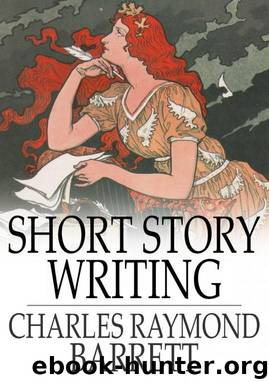Short Story Writing by Raymond Charles Barrett

Author:Raymond Charles Barrett
Language: eng
Format: mobi, epub
Tags: Language Arts & Disciplines, Authorship, Short Stories (single author), Fiction
ISBN: 9781775416371
Publisher: IndyPublish.com
Published: 2007-06-11T10:00:00+00:00
IX - The Story Proper
*
The correct short story possesses unity of form as well as unity of plot. In the novel there may be wide gaps of time and scene between adjacent chapters; but the short story allows of no such chasms of thought, much less of chapters. Parts or chapters in a short story are uncanonical. A short story is essentially a unit, and the necessity of divisions indicates the use of a plot that belongs to some larger form of literature; but the indicated "parts" or "chapters" may be false divisions introduced through the influence of the conventions of the novel.
The various divisional signs to be avoided are the separate entries or letters of the diary or epistolary forms, the introduction of stars or blank spaces to indicate a hiatus, and the division of the narrative into parts or chapters. The evils of the diary and epistolary forms have already been discussed and need no further comment. The use of stars or spaces either is due to an improper plot, or is entirely unnecessary. In the first instance the fault is radical, and the only remedy is complete reconstruction; in the second case the difficulty resolves itself into an ignorance or a disregard of rhetorical conventions. Often the story is deliberately divided and forced to appear in several chapters when its plot and treatment make its unity very evident; and solely because the amateur has an idea, caught from his novel reading, that such divisions are essential to a well told story. They are not necessary to many novels, though they may be convenient; and they have no place in the scheme of the short story. There are stories, "short" at least in length, in which divisions are necessary to indicate breaks which do not seriously interrupt the coherency of the narrative; they may be readable stories, but they can never be models.
The ideal short story, from the point of unity, is one which requires the passage of the least time and presents the fewest separate incidents. It is the relation of a single isolated incident, which occupies only the time required to tell it. "The Ambitious Guest" impresses the reader as a single incident and would seem to approach this perfection, but a careful analysis of it resolves it into a number of minor incidents, so closely related and connected that at first glance they appear to form a perfect whole. The component incidents of the body of "The Ambitious Guest" (¶ 5-39) are:
¶ 5-7. The stranger praises the fire and reveals his destination.
¶ 8, 9. A stone rolls down the mountain side. (Lapse of time indicated here.)
¶ 10, 11. The characters are described, as they reveal themselves through their conversation.
¶ 12-23. They converse rather frankly of their several ambitions.
¶ 24-27. A wagon stops before the inn, but goes on when the landlord does not immediately appear.
¶ 28-31. A touch of sentimental byplay between the stranger and the maid.
¶ 32. A sadness creeps over the company, caused, perhaps, by the wind wailing without.
Download
Short Story Writing by Raymond Charles Barrett.epub
This site does not store any files on its server. We only index and link to content provided by other sites. Please contact the content providers to delete copyright contents if any and email us, we'll remove relevant links or contents immediately.
The Art of Coaching Workbook by Elena Aguilar(50984)
Trainspotting by Irvine Welsh(21518)
Twilight of the Idols With the Antichrist and Ecce Homo by Friedrich Nietzsche(18503)
Fangirl by Rainbow Rowell(9095)
Periodization Training for Sports by Tudor Bompa(8170)
Change Your Questions, Change Your Life by Marilee Adams(7635)
This Is How You Lose Her by Junot Diaz(6794)
Asking the Right Questions: A Guide to Critical Thinking by M. Neil Browne & Stuart M. Keeley(5632)
Grit by Angela Duckworth(5523)
Red Sparrow by Jason Matthews(5390)
Paper Towns by Green John(5089)
Room 212 by Kate Stewart(5035)
Ken Follett - World without end by Ken Follett(4645)
Housekeeping by Marilynne Robinson(4344)
The Sports Rules Book by Human Kinetics(4291)
Double Down (Diary of a Wimpy Kid Book 11) by Jeff Kinney(4207)
Papillon (English) by Henri Charrière(4195)
The Motorcycle Diaries by Ernesto Che Guevara(4012)
Exercise Technique Manual for Resistance Training by National Strength & Conditioning Association(3955)
